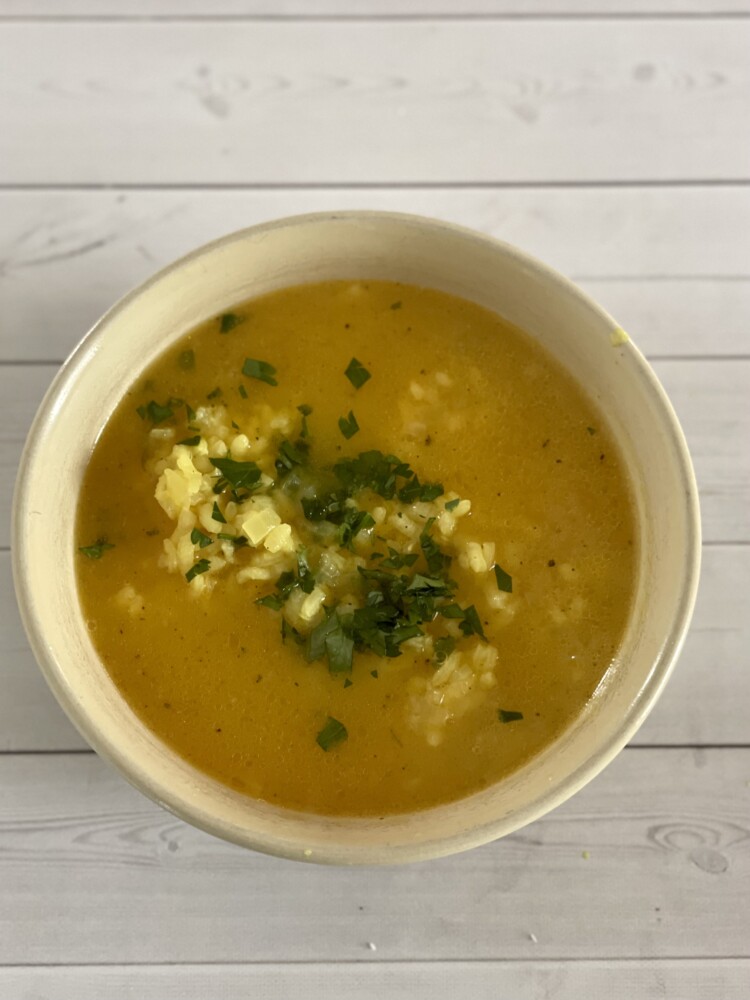I send my mom purple irises on most Mother’s Days. Some years, though, I travel to western Massachusetts to present them in person. She – her name is Alba — loves them, first and foremost. But they also symbolize faith, hope, courage and wisdom, all the intangibles I see in her in spades. These flowers are a fitting gift on several levels.
Mother’s Day also conjures for me memories of my grandmothers and the sustainable foodways (eating habits and culinary practices of a people, region, or historical period) they handed down to me. I’ve introduced readers to Mabel, my great-grandmother on Alba’s side, whom I visited most Saturdays until she passed away when I was 16. She could peel apples with a paring knife to yield a single long strand of a peel. And I’ve written about her daughter Elizabeth, my Nan, who made Easter bread so colorful it hardly seemed real. I’m sorry my kids didn’t know Mabel and can’t remember Liz.

Onions, which you probably already have in your pantry, are one of the few ingredients you need to make Nonna’s soup. Photo by Christine Burns Rudalevige
I’ve mentioned my paternal grandmother Alma, my Nonna, in a recipe headnote on how to simply prepare tender spring dandelions. Well into her 70s, she was a cook at the nursing home down the street from her home, just up the same street from ours. Since she cooked professionally, she was not generally up for also churning out big family meals at home. Based on her work schedule, she’d either come to our house for Sunday lunch after 11 a.m. Mass or we’d bring Genoa salami and Vienna bread for sandwiches to her house on our way home from the 5:30 p.m. service.
But if you happened to visit her around lunchtime on a rainy weekday, she would gladly whip up a bowl of chicken broth and rice for you as you sat at her laminated topped table and chatted about life. I preferred her soup to my mom’s because it had no mushy celery or dark meat in it, both of which I avoided as a kid. She’d line the bowls with orange-edged, deli-sliced muenster cheese that fortified the broth and stretched from the bowl to your mouth as you consumed it.
It wasn’t until recently that my dad told me there was no chicken at all in Nonna’s soup. Not even a bouillon cube. Only onions – salted and very slowly sweated in butter, water from the tap, rice from the pantry and black pepper. At first, I felt cheated, misconstruing the whole food memory as a fake. But then I recognized the truth of the matter. Nonna, from the grave, was schooling me in the art of sustainable pantry cooking. Take what you have on hand and make a memorable meal out of it.

Not Much Chicken Broth and Rice. The name refers to the few needed ingredients. But the taste is far more than “not much.” Photo by Christine Burns Rudalevige
Not Much Chicken Broth and Rice
Unlike my Nonna, I keep both turmeric and dried kelp in my pantry. I don’t know if she’d approve, as she wasn’t a fan of either change or what she’d consider exotic ingredients. Nonetheless, I add the former for color and the later for an umami blast to my version of her dish.
Serves 4
4 tablespoons unsalted butter
1 cup finely diced yellow onion
1 teaspoon kosher salt
1/8 teaspoon ground turmeric
1½ cups uncooked medium grain rice
(One) 4- by 4-inch piece of dried kelp
Black pepper to taste
4 thin slices of local alpine cheese
Chopped parsley, for garnish
Melt the butter in a large heavy-bottomed pot over low heat. Add the onion, salt and turmeric and stir to coat the onions in both fat and spice. Cook slowly until the onions are soft and translucent, 4-5 minutes. Add the rice, stir to coat it in fat. Stir in 6 cups of water. Add the dried kelp.
Increase the heat to medium to bring the mixture to a simmer. Cook until the rice is tender, but not mushy, about 18 minutes. Remove and compost the kelp. Season the soup to taste with black pepper.
To serve, line warm soup bowls with slices of cheese. Ladle the soup into the bowls. Garnish with parsley and serve hot.
Send questions/comments to the editors.


